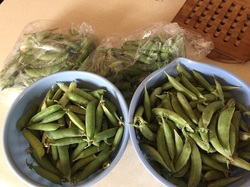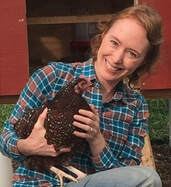 Peas, peas, and more peas!
Peas, peas, and more peas! Spring was early this year, and then late - back and forth between unseasonably warm and unseasonably cold all the way up into May. But somehow the garden still ended up ahead of last year - except for the parts I am still behind on! We already have little green tomatoes of all kinds out in the garden, okra is up (this time last year I hadn't even planted it yet), and lettuce and peas are almost finished (our best pea crop so far, by far!).
For some reason, every year I think this year I will somehow manage to be not as stressed out during the hectic spring and early-summer in the garden, but it never happens! Last year I thought I would be done with preparing new beds for a while (always an incredibly laborious and time-consuming process), but then we ended up with fewer hay bales this year, so I decided to create one more row of beds so that area wouldn't to go waste this year. Well, it's nearly July and I STILL don't have them done, although getting close, and I should finish them this week at last... Our soil is so heavy and dense, it is nearly impossible to dig if it's not the perfect moisture level. For most of the spring, it has been either way too wet (with standing water in the aisles), or way too dry (like concrete - can't even get a fork into it), so I've been lucky to get one day out of the week sometimes where it is actually workable.
Fortunately, we got 2 1/2" of rain a few days ago, after a long, hot, dry spell, and now it is cool, breezy, and beautiful - perfect for working outside, and the soil is nice and moist - so I'm on the home stretch! My husband is finishing up the bed boxes today, so we should have them framed by the end of the week - so I can finally plant the beans!
We were blessed the first year here to have relatively few, except for the asparagus beetles. Last year the squash bugs showed up, though not until late in the season, and a few more cucumber beetles, plus lots of flea beetles. This season, it is game on! Word is out in the neighborhood that there is a delicious, chemical-free smorgasboard just ready for the taking...
And the bugs have arrived for real.
While we didn't have squash bugs last year until late July, now they are already out and about, laying eggs and sucking juices from my poor squash plants, which are already under a lot of stress as I shall describe in a moment. Not many yet, so I'm trying to keep ahead of them by picking regularly. The Japanese beetles, which have always been a problem here, are worse than ever this year - just now arriving in swarms to feast upon the belabored asparagus, as well as the potatoes, tomatilloes, and my flower beds.
But the worst of it this year so far has been the cucumber beetles. They are everywhere - hordes of hungry little beasts ready to suck out the juices of all my melons, cucumbers, and squashes, chew through the stems, and munch holes in all of the leaves. They are very fast, fly far, and burrow into the dirt to hide if they drop off a plant, so they are incredibly difficult to pick by hand.
They killed my one honeydew melon within days of planting it outside in the garden, as well as one of my cantaloupe seedlings, one of my watermelons, and 2 new baby squash seedlings. The larger squash plants have been hard hit as well, though fortunately they were already established when the worst of the beetle scourge arrived. The bugs seem to have only recently discovered the cucumbers (in a different area of the garden), and have completely eaten off several long tendrils that were already climbing the trellis and beginning to bloom.
Much of my time in the garden lately has had to be directed to trapping and picking cucumber beetles, and attempting various organic means to try to control them. Along with twice daily picking (whenever possible), I set up some "traps" I read about online - yellow bowls (supposedly they are attracted to yellow) filled with water and a couple of drops of dish soap. While not a lot of them seem to fall in on their own, it does make picking easier, as I can sometimes shake them off the leaves into the bowls, where they will die quickly in the soapy water.
Along with the bowl traps, for deterrents I started with diatomaceous earth, which was one of the suggestions I read about online, plus it was something I already had on hand, having recently bought a 5-lb bag of it for general garden use. Some users posted online that they found the cucumber beetles did not like walking in it, so I sprinkled it on and around the leaves of the plants and on the bales where they are planted. It has perhaps helped a bit, but not to protect new seedlings. I discovered 3 cucumber beetles finishing off the last of my replanted honeydew seedlings this morning, while completely coated with DE powder! However, for the less-tasty larger plants, it does seem to deter them somewhat - though it took several days to see a difference in numbers. I am cautious about using it on the cucumbers though, as they are blooming, and I know that DE kills bees, which I am very sensitive about.
My next attempt will be neem oil, which I also have on hand, but am not sure how much it will help - it didn't seem to help with the asparagus beetles at all... For that, I shouldn't have to worry too much about the bees, as from what I have read, neem doesn't bother them much as long as it isn't sprayed directly on them, so I will spray in the evening when the bees aren't around.
And for the third prong of attack, I purchased some beneficial nematodes, which I've read are one of the best ways to control cucumber beetles, BUT they only work on the larvae in the soil, so won't help with the current infestation. I'm hoping if I apply this year, next year there won't be so many? On the plus side, they are also supposed to work for asparagus beetles, which I had never read anywhere before, despite all my research on controlling them! So I also treated the asparagus bed, and we will see how it goes...
My next option if things don't improve soon will be a Spinosad insect spray, which, though organic, is more toxic to many insects, so I wanted to use that as a last resort if these other options don't work. I'm hoping the DE and the neem oil will help lessen the pressure from the adults, while the nematodes will prevent new hatches from making it to maturity.
Besides their incredibly destructive appetites, cucumber beetles also carry various wilt diseases, which I now think is what killed all of my melons last year, as well as my cucumber plants (although, by then, those were about done fruiting). So even though we didn't have that many beetles last year, they still destroyed part of my garden - including my unripe melons, which I was so sad about! I never thought I could hate an insect pest worse than asparagus beetles, but cucumber beetles are pure evil!!!
The early warm weather has meant that the garden is ahead of last year, and everything (except for the melons and squash) is looking amazingly beautiful, vibrant, and healthy. I told my husband that I think we are definitely on track for our prettiest garden ever this year!
And our newest experiment should hopefully cut down on my ongoing workload in the garden, as well as make it practically magazine-worthy. :-)
After reading a lot about using wood chips in the garden, I mentioned to my husband that we could try using wood chips to keep the weeds down in the garden aisles between the beds. We had discussed various options for this before, as maneuvering the push mower between the beds is very difficult (though my husband does a great job with it, but it has been frustrating for him), plus the short aisles have irrigation lines crossing them, so I had to weed those sections by hand all summer last year.
And even with mowing the longer aisles, I still had to constantly weed around the edges of the bed frames, and whenever we got a lot of rain, the aisles all turned into mucky, mosquito-filled swamps. My husband had mentioned gravel, but I didn't really want to add a lot of rocks to our garden, even small ones, plus I figured they would be uncomfortable to walk on, and while it might look nice at first, over time, they would become algae coated, muddy, and not very attractive after all. And I wasn't sure they would make a very good weed barrier anyway.
Leaves look nice and work wonderfully at keeping weeds down, but our one giant maple tree only provides enough to barely mulch one aisle, and they have to be replaced every year as they decompose fairly quickly.
What about wood chips?
I had read online that you can often get them free from municipal departments or tree-trimming services. My husband said he would look into it, and on my birthday, at the end of May, he showed up in our driveway with a pickup-truck-load of beautiful, aromatic wood chips!
He found a couple of different sources which would give him chips whenever they have them, so we have been hauling wood chips for the past several weeks, and piling them 4-5" deep in the aisles around the beds. We are almost finished now - just 2 aisles left to go, and then if we can get more I think we will also go ahead and mulch the areas between the hay bales as that section of the garden is just covered with cardboard right now, which doesn't look that nice, and some weeds do find their way through it. Plus I think it will be better for the soil underneath.
Someone said online that if you put them down too deep, they could smother the earthworms, but I have not found that to be the case at all. In fact, when I have dug a couple of inches down to dig out weeds, I have found dozens of active and happy earthworms working away in the moist chips.
I also read somewhere that they may help the raised beds retain moisture longer, so we will see - I haven't tested that theory just yet, but it does make sense.
While this year in the garden has so far been a mixed bag, overall I am optimistic and hoping for a wonderful season!
I hope your summer is going well and that you are blessed in your own gardening and homesteading endeavors!
Rose.









 RSS Feed
RSS Feed